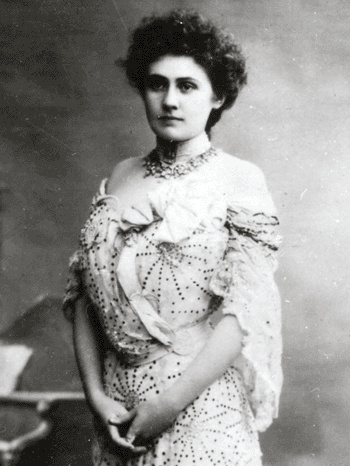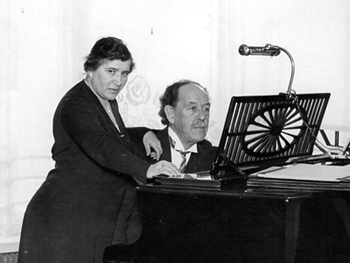
Aino Ackté
Sibelius's Soloists
Several of Sibelius's early songs were performed by the Finnish bass baritone Abraham Ojanperä. After the early 1890s, the songs were mostly performed by female singers, mainly Finnish sopranos. The singers who most inspired Sibelius were Aino Ackté, who in Finland performed mostly with Oskar Merikanto, and Ida Ekman, who generally performed with her husband Karl Ekman: it was for them that Sibelius composed and dedicated the majority of his songs.

Ida and Karl Ekman
The artistic temperaments and voice types of these singers had a considerable influence on Sibelius's development as a writer of songs. To Aino Ackté Sibelius gave songs with a dramatic recitative; Sibelius dedicated Höstkväll and Luonnotar to her. Ida Ekman, on the other hand, was a lyrical soprano. Sibelius dedicated to her a great number of songs. She was the first singer to perform Var det en dröm? (op. 37 no. 4) and the
Floral Suite (op. 88). 88. In addition to these two sopranos Sibelius's songs received first performances from the following artists: Alexandra Ahnger; Maikki Järnefelt and Adée Leander-Flodin; Anna Hagelstam; Maikki Järnefelt; Alma Kuula.
After 1910 it became rare for Aino Ackté to perform Sibelius's new songs. Instead, Ida Ekman's crucial role as an interpreter of the songs increased further. After listening to Aino Ackté's rehearsals in 1918 Sibelius wrote in his diary: "They - our female singers - 'they make too much' of every phrase. The absolute music which I write is so exclusively musical and strictly independent of words that reciting them is not a good idea. Ida Ekman has understood this which is why she is incomparable." Sibelius wrote all his last three song collections for Ida Ekman, who was at that time finishing her career. She performed Sibelius's songs during her farewell concerts. In 1919, Aino Ackté, too, ended her career as a singer, and it is not surprising that from then on Sibelius hardly composed any new songs.

